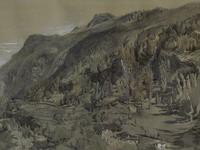John Ruskin and the Geographical Imagination
Denis Cosgrove selects works from Ruskin’s Teaching Collection and reveals a poetry of landscape that inspired geographical learning a century ago.

From his earliest encounter with the mountains as a young man, the Alps remained central to Ruskin’s geographical imagination. Walking, sketching, observing their forms and changing atmosphere was a source of consistent pleasure and inspiration. But Ruskin’s interest was more than aesthetic, his contributions to alpine geology gained respect from geologists, and his text Deucalion discusses many of the questions of glacial geomorphology later to be examined in the undergraduate geography curriculum.
The natural tendancy of accurate science is to make the possessor of it look for, and eminently see the things connected with his special pieces of knowledge; and as all accurate science must be sternly limited, his sight of nature gets limited accordingly … And I was quite sure that if I examined the mountain anatomy scientifically, I should go wrong in like manner, touching the external aspects. Therefore,…I closed all geological books, and set myself as far as I could to see the Alps in a simple, thoughtless, and untheorising manner; but to see them, if it might be, thoroughly.' (6:475) 'I think it is one of the best sketches I ever made of the thing I loved best.' (21:144)

The Glacier des Bossons, Chamouni
'The hills, which, as compared with living beings, seem 'everlasting' are, in truth, as perishing as they; its veins of flowing weary the mountain heart, as the crimson pulse does ours … and it is but the lapse of the longer years of decay which, in the sight of its creator, distinguishes the mountain range from the moth and the worm.' (6:176-177) Today, the glacier has retreated more than one mile up the valley from the point shown in Ruskin’s image.

The Brezon, and Alps of the Reposoir, seen from Mornex
'An example of mountain drawing in pure pencil will show what kind of labour I had to go through in gaining my knowledge of mountain form.' Ruskin notes that at the time of its production this sketch was intended to contribute to 'some records of Swiss scenery which would have been precious' (his intended but never written 'historical geography' of Swiss landscape), but that 'even while I was finishing the shadows above the valley of Bonneville in this sketch, I was writing the first passage of Unto this Last.' (21:209-210) In fact, he was composing Munera Pulveris, but the sentiment of abandoning picturesque scenery for contemporary social comment is telling.
References
All references to Ruskin's writings are taken from The Works of Ruskin, Library Edition, 39 volumes, edited by E.T. Cook and Alexander Wedderburn, George Allen, London, 1903-1912 and given by volume number and page.





